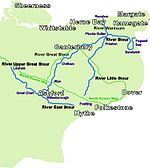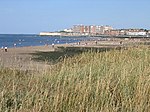All Saints' Church, Shuart (), in the north-west of the Isle of Thanet, Kent, in the south-east of England, was established in the Anglo-Saxon period as a chapel of ease for the parish of St Mary's Church, Reculver, which was centred on the north-eastern corner of mainland Kent, adjacent to the island. The Isle of Thanet was then separated from the mainland by the sea, which formed a strait known as the Wantsum Channel. The last church on the site was demolished by the early 17th century, and there is nothing remaining above ground to show that a church once stood there.
The area of the Isle of Thanet where All Saints' Church stood had been settled since the Bronze Age, and land in the west of the Isle of Thanet was given to the church at Reculver in the 7th century. All Saints' Church remained a chapel of ease for the parish of Reculver until the early 14th century, when the parish was broken up to form separate parishes for Herne and St Nicholas-at-Wade. The area served by All Saints' was merged with that of St Nicholas-at-Wade, which became the centre of a new parish with All Saints' as its chapel. The churches of All Saints and St Nicholas continued to have a junior relationship with the parish of Reculver, making annual payments to the church there.
All Saints' originally consisted of a nave and chancel, to which a sanctuary was added in the first building phase. The church was extended on three occasions between the 10th and 14th centuries – a period of population growth – to include an aisled nave, a western tower and a northern chapel; its windows featured stained glass. The church was abandoned in the 15th century, presumably because the parish could no longer support two churches. It was demolished, and virtually all of its masonry removed, some of which may have been used in improvements to the church of St Nicholas. The settlement of Shuart remained as an area of local administration into the 17th century, but it is now regarded as a deserted medieval village. There were no visible remains of All Saints' Church by 1723, although land there remained as glebe belonging to the parish of St Nicholas. The site of All Saints' Church was excavated by archaeologists between 1978 and 1979. The main structure had been robbed of its materials leaving only the foundations, from which the archaeologists were able to interpret the history of the building's construction and its form. Among the foundations were discovered numerous stone carvings, floor tiles, remnants of stained glass, and several disturbed graves.










